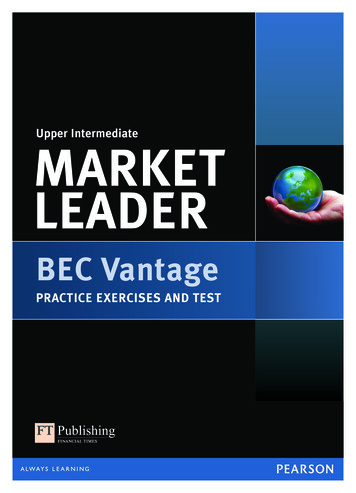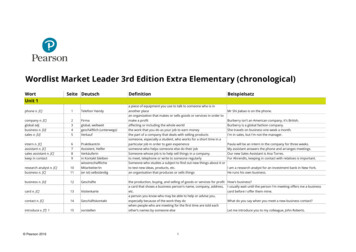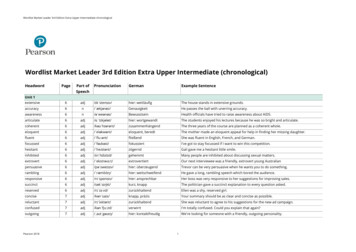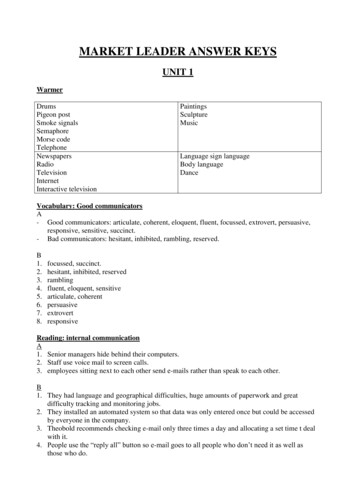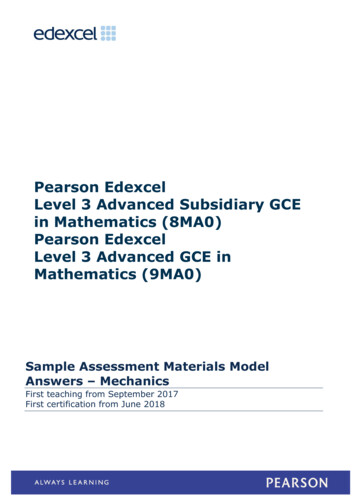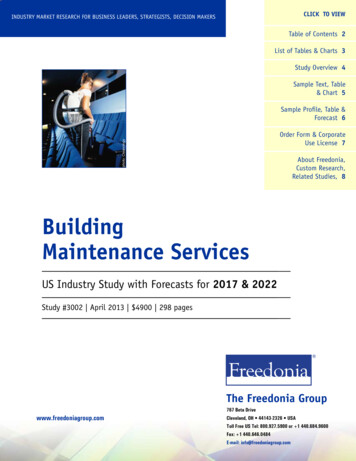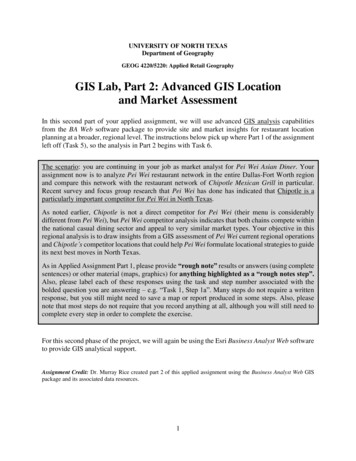
Transcription
AdvancedMARKETLEADERBEC HigherPRACTICE EXERCISES AND TESTML BEC Higher CVR.indd 110/02/2015 09:34
Pearson Education LimitedEdinburgh GateHarlowEssex CM20 2JEEnglandand Associated Companies throughout the world.www.pearsonelt.com Pearson Education Limited 2015The right of Lizzie Wright to be identified as author of this Work has beenasserted by her in accordance with the Copyright, Designs and Patents Act1988.All rights reserved; no part of this publication may be reproduced,stored in a retrieval system, or transmitted in any form or by any means,electronic, mechanical, photocopying, recording, or otherwise without theprior written permission of the Publishers.First published 2015ISBN: 978-1-4479-9950-8Set in MetaPlus 9.5/11ptPrinted in Slovakia by NeografiaAcknowledgementsWe are grateful to the following for permission to reproduce copyrightmaterial:TextArticle on page 4 from The rule breaker at IWC on the move to go global(Elizabeth Paton), The Financial Times Limited. All Rights Reserved;Article 5. from Overworked and uninspired the misery of the middlemanager (Lucy Kellaway), The Financial Times Limited. All RightsReserved; Article 7. from What the best parents can teach us aboutmanagement (Michael Sapinker), The Financial Times Limited. All RightsReserved; Article 12. from Dixons Carphone case study: the hard work afterthe merger fanfare (Andrew Hill), The Financial Times Limited. All RightsReserved; Article on page 27 from For teenage tycoons it is a case of jamtoday (Emma Jacobs), The Financial Times Limited. All Rights Reserved;Article on page 28 from BUSINESS LIFE - Lessons from a corporate healthscare in China (Josh Noble), The Financial Times Limited. All RightsReserved; Article on page 30 from The Lex Column - consumer goods:luxury prices (Lex’), The Financial Times Limited. All Rights ReservedIn some instances we have been unable to trace the owners of copyrightmaterial, and we would appreciate any information that would enable usto do so.A00 MARK CB ADVGLB 8890 IMP.indd 114/05/2015 13:25
IntroductionBEC Higher Practice Exercises bookletThis booklet offers practice for BEC Higher examwith a strong tie-in to Market Leader Advanced. Itprovides Reading and Writing tasks that will helpfamiliarise students with the different task typesand give practice for the exam, as well as act asrevision practice for non-exam students. Each unithas one Reading and one Writing task, which areclosely aligned to the vocabulary, grammar andtopic of the corresponding Market Leader unit.Furthermore, each task has been aligned to theGlobal Scale of English, developed by Pearson, toensure that it is at the appropriate level.Speaking and Listening tests have not beenincluded in the practice booklet, but MarketLeader Advanced Course Book provides plentyof BEC-relevant practice for these skills. Specificinformation showing how the Course Book can beused as practice for the Listening and Speakingexams is included in the Teacher’s Notes, which canbe found on the Market Leader website.How to use this practice bookletThe exam tasks can be used as both a teachingand a testing device. A tip box at the beginningof each task gives advice on how to approach thetask. Teachers can work through the tasks withthe students at first, helping them to analyse thetask closely in order to develop exam techniquesof speed and accuracy. Students will benefitfrom the opportunity to develop techniques forapproaching the tasks, which will reduce the timepressure many students feel when faced with thereal exam.INTRODUCTIONThe Market Leader series is a fantastic resourcefor students aiming to take the BEC exams as itcovers and practises the kind of language requiredin an international business environment. Whenworking through the Market Leader Advanced units,students should be encouraged to skim read, toguess the meaning of unknown words and to findsynonyms and paraphrases for common words andexpressions as these are all skills which will helpwith the BEC Higher exam.Reading tasksThe Reading tasks use some authentic FT articles,slightly adapted to suit the level, as well as textsspecially written to match BEC exam tasks. These willnaturally have some unknown vocabulary and willhelp students to practise finding the answers despitenot being familiar with some of the language. Wherepossible, vocabulary and grammar from the units aretested, but all the targeted language matches thetype of language tested in the BEC exam.Writing tasksAll the Writing tasks are linked to the topic ofthe corresponding Market Leader Advanced unitand accurately reflect the exam task formats thatstudents will encounter. Once again, teacherscan work through the first few Writing tasks withthe students, guiding them on how to approacheach task, especially making sure that all thecontent points required for the task are included inresponses. After that, the tasks will give studentsan opportunity to practise answering the questionswithin the time allowed as well as help them tobecome familiar with the number of words requiredfor each task.BEC Higher practice testAt the end of the booklet there is one full Readingand Writing practice test for BEC Higher, whichshould be carried out under exam conditions. Thisallows both teachers and students to gauge howready they are to take the exam and to give theman idea of what grade they could expect in thesetwo papers.1M01 MARK BKL ADVGLB 9508 M01.indd 121/05/2015 10:26
unit1READING AND WRITINGREADINGPART ONEReading and WritingTIPS–– Read the questions carefully first.–– The words in the questions are usually not the same as the words in the text so look forparaphrases in the text. Words from the questions may well be in other texts.–– Make sure the text matches the question exactly. Look at the statements below from an article about first impressions. Which section (A, B, C, D or E) does each statement 1–8 refer to? For each statement 1–8, mark one letter (A, B, C, D or E). You will need to use some of these letters more than once.Example0 A decision to talk to someone is often made by just hearing their voice.D1 Grooming and attire are extremely important for an initial contact.2 First impressions often take precedence over factual knowledge.3 Studies prove that initial impressions favour indications of knowhowand honesty.4 Quick assessments of people are counteracted by a morethoughtful process.5 The ability to do a job well is more important than self-assurance.6 We judge people more favourably if contact with them could bebeneficial to us.7 People have an instinctive reaction to vocal sounds heard for the first time.8 The ability to maximise one’s best features is very useful in business.AHowever hard we try, first impressions usually remain with us and affect every aspectof business: meetings, presentations, interviews, demonstrations, advertising and webdesign, for example. Research shows that it only takes a twentieth of a second for aperson to decide if they like a webpage or not. So, if a potential customer takes againstthe site immediately, business will be lost, even if the product or service offered is secondto none. First impressions are so powerful that they will often override whatever peoplemay tell us to the contrary about a person.BExperts believe there are two thought systems in our brains. The first is fast, intuitive andemotional, and is involved in first impressions. The second is slower, more contemplativeand logical. The former comes into play in that split-second when first seeing or hearingsomeone. Furthermore, we assess people according to our own social or business world,so if we feel that they will be useful to us, we will focus more on their positive aspectsthan their negatives. This is when the second system is brought into play so that snapjudgements are balanced out.2M01 MARK BKL ADVGLB 9508 M01.indd 221/05/2015 10:26
UNIT 1 READING AND WRITINGCNevertheless, it is appearance that tends to blot out all other aspects in the first instanceand, as people make up their minds about someone in the first four to seven seconds,then it is a no-brainer to ensure you look the part. If someone fits in with our idea ofa trustworthy, good person, then we may lean towards a favourable view of them.Successful movers and shakers are able to leverage all their attributes to their greatestadvantage when networking or making business deals.READING AND WRITINGDWhen presenting yourself or your company to a roomful of people, the intonation andmodulation of your voice can indicate how trustworthy people perceive you. For example,the first greeting can seal that first impression and determine whether the listener willwant to continue the interaction. Research suggests that some voices just sound moretrustworthy and pleasant. Experts have discovered that our ability to judge whether toapproach someone is often based on the first utterance from them, has evolved overmillennia and is used by all mammals.EEstablishing credibility as quickly as possible is vital if business deals are to besuccessfully negotiated and sealed. Appearance, voice, gestures and mannerisms are allabsorbed to create a first impression. Many people say that a strong handshake indicatesa confident professional and it helps to confirm a good first impression. However,research has shown that confidence is not necessarily the most important characteristicwe seek. Instead it seems that we are concerned mainly with two traits which account forbetween 80 and 90 per cent of first impressions: competence and trustworthiness.WRITINGPART ONETIPS–– Read all the instructions carefully and underline key words.–– Look at the graphs carefully to make sure you understand fully what they represent.–– Check the format required (email, letter, report, etc.).–– Write at least 120 words. If you write fewer you will lose marks. You do not get extra marksif you write more than 140 words. A local networking group aims to help start-ups in the area. The first chart below shows theunemployment situation in the local area and the number of applicants wanting financialsupport. The second chart shows the amount of money available to help. Using the information from the charts, write a letter inviting companies to join the networkand support the investment. Write 120–140 words.Local Funds 20122013government grants20142015private investment3M01 MARK BKL ADVGLB 9508 M01.indd 321/05/2015 10:26
unit2READING AND WRITINGREADINGPART FOURReading and WritingTIPS– Read the text through quickly so you know what it is about.– Think about the meaning of each missing word.– The four options usually have similar meanings.– Look carefully at the text before and after each gap.– Make sure that the word fits with the grammar, collocations and phrases of the text.– Read the whole text through again to see if it makes sense with your choices. Read the article below about graduates and apprentices. Choose the best word to fill each gap from A, B, C or D. For each question 1–10, mark one letter (A, B, C or D). There is an example at the beginning.GRADUATES VERSUS APPRENTICESIn the past, school (0) B have been encouraged to (1)on a university educationbecause it would guarantee a quick route to a good job with security andbenefits. People spoke of apprenticeships in a particularly (2)way, rarelyapplauding their value and suggesting this course to those who were consideredacademically weak.However, the business world has changed considerably since those days and thecurrent thinking is that recruiting apprentices is a better option for companies.Furthermore, apprenticeships which provide both work experience as well asfor university study, seem to offer the best of both worldsgiving them a(n) (3)for companies and employees.In today’s fast-changing world, it is imperative that companies have staff whoand who have the ability to (5)can connect the (4)opportunities when facedwith them. When employing graduates it can take quite a long time before theyunderstand the company and its work culture, whereas the apprentice not onlyhas sector-relevant skills as they have been (6)but they also (7)these ever since they started,in much more quickly.Research has shown that today many employers regard graduate skills as beingsomewhat (8)from practice and the necessary industry knowledge so that theyare unable to make an immediate impact on the business. Employing graduatescan often mean having to (9)teams in order to accommodate them insteadof their being able to contribute effectively to the team. It is therefore widelyrecognised that having an apprenticeship system within a company (10)severalinvaluable benefits.4M01 MARK BKL ADVGLB 9508 M01.indd 421/05/2015 10:26
UNIT 2 READING AND WRITING0 A finishersB leaversC endersD workers1 A trainB learnC embarkD educate2 A pejorativeB indignantC offendedD disrespected3 A budgetB accountC leverageD allowance4 A spotsB dotsC pointsD marksB dotC glanceD glimpseB reviewingC honingD appraising7 A sitB setC fitD get8 A separatedB distancedC splitD divorced9 A familiariseB rejigC exposeD accustomB educatesC revealsD discloses10 A confersWRITINGPART TWOREADING AND WRITING5 A spot6 A rehearsingTIPS–– Read all the instructions carefully and underline key words.–– Check the format required (proposal, letter, report, etc.).–– Structure your answer with clear paragraphs.–– Use a range of business words and linkers.–– Keep checking the question to remember the purpose of writing.–– Write at least 200 words. If you write fewer you will lose marks. You do not get extra marksif you write more than 250 words. Your HR Director has asked you to summarise the benefits of two training courses whichstaff attended in the past year as there was negative feedback from some staff. Suggest anew course for the coming year. Write a proposal, including the following points:– brief det
the corresponding Market Leader Advanced unit and accurately reflect the exam task formats that students will encounter. Once again, teachers can work through the first few Writing tasks with the students, guiding them on how to approach each task, especially making sure that all the content points required for the task are included in responses. After that, the tasks will give students an .File Size: 2MBPage Count: 36
